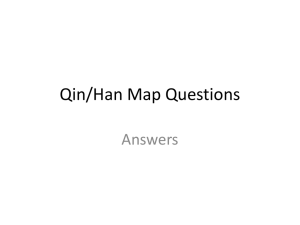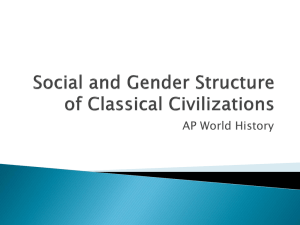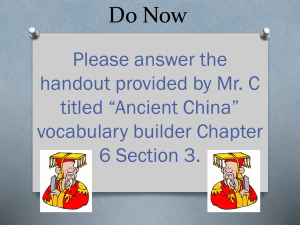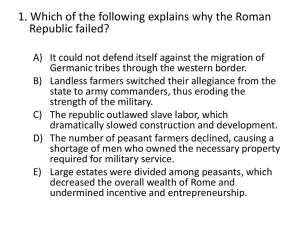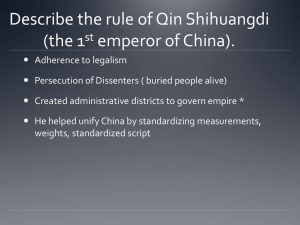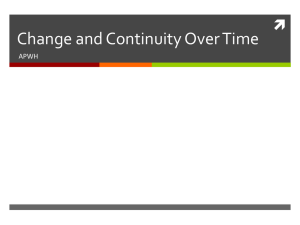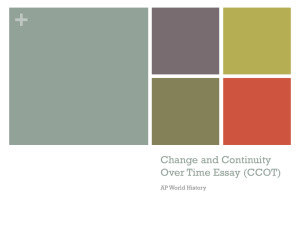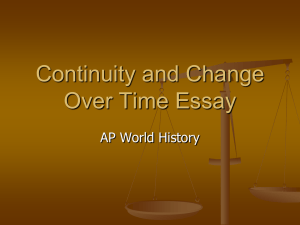Change
advertisement
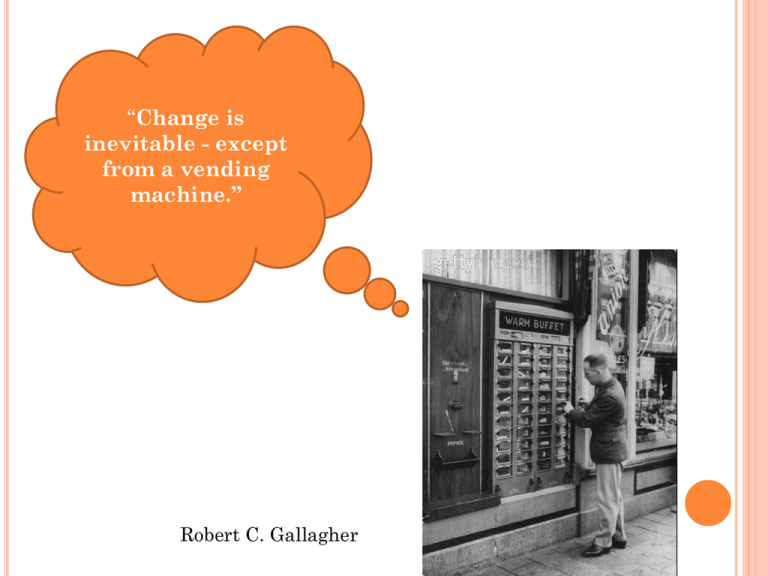
“Change is inevitable - except from a vending machine.” Robert C. Gallagher CONTINUITY AND CHANGE OVER TIME The Continuity and Change Over Time (CCOT) essay question tests the student’s ability to trace a broad trend or development over a long period of time The CCOT lends itself to a topical approach Topics may include cultural interchange, global trade, the movement and migration of peoples, the role of minorities in a given society, the status of women, environmental issues, biological developments, changes in technology, artistic and cultural attitudes, and scientific innovations GENERAL TIPS FOR WRITING A CCOT Students should take 40 minutes to complete the CCOT essay Students should spend 5 of the 40 minutes reading the question, reflecting on the question, and organizing thoughts concerning the essay The CCOT will request that students analyze the evolution of a trend or phenomenon over a long period of time Students will be asked to focus on a particular nation or geographical region and may be given a choice regarding which nation or region must be included in the essay The requirements for the CCOT are more straightforward than those for the DBQ. However, students must concentrate on showing what changed and how it changed as well as what remained the same. THOUGHTS TO CONSIDER BEFORE WRITING What were things like at the beginning of the assigned period? What changed? How and why did it change? What were things like at the end of the assigned period? What differences did those changes make? What remained the same? Definition: Change To make different in some particular ~Merriam-Webster dictionary Definition: Continuity Uninterrupted connection, succession, or union ~Merriam-Webster dictionary SO, WAIT A MINUTE It’s not just about change but about what remained the same Don’t forget the continuity part of the Continuity and Change Over Time Essay Let’s Practice! FROM THE 2006 WORLD HISTORY AP EXAMINATION (COURTESY OF COLLEGE ENTRANCE EXAMINATION BOARD): Analyze the cultural and political changes and continuities in ONE of the following civilizations during the last centuries of the classical era. Chinese, 100 C.E. to 600 C.E. Roman, 100 C.E. to 600 C.E. Indian, 300 C.E. to 600 C.E. READ THE DIRECTIONS CAREFULLY Analyze cultural and political changes But also analyze continuities Choose ONE civilization Focus on last centuries of classical era FACTS ABOUT CHINA (100 C.E. – 600 C.E.) The Han Dynasty ruled China from 206 B.C.E. – 220 C.E. (Of course, this is only part of the time period provided) Han rulers: -Created an efficiently governed empire -Expanded hundreds of miles to the west, north, and south -Established a tributary system (exacting payment from neighboring states) with areas that were not taken over directly -Established an effective administration, postal service, and a tax-collecting system Han rulers also built roads, defensive fortifications (enlarging the Great Wall), and canals to link the country’s major rivers During most of the Han dynasty, the economy was strong The Chinese had a monopoly on silk production But by 200 C.E., the Han state was in decline Decreased agricultural production, governmental corruption, and weak leadership contributed to the decline Outside invaders, bandits, and rebels on the frontiers also made it difficult for the Han to protect their borders In 220 C.E., the Han dynasty collapsed Over the next three and a half centuries, several minor dynasties rose and fell, while China itself was in a state of chaos and anarchy Not until 589 C.E. did a strong dynasty, the Sui (589-618), reestablish order FACTS ABOUT ROMANS (100 C.E. – 600 C.E.) The Roman Empire remained in place for approximately five centuries, from 31 B.C.E. to Rome’s downfall in 476 C.E. The first emperor was Julius Caesar’s adopted son, Octavian, who renamed himself Caesar Augustus (30 B.C.E. – 14 C.E.) [But this is not the time period for this essay!] So, while August restored order, revived Roman strength and wealth, and enjoyed a long reign as a respected ruler, emperors that followed were more despotic [this is the time period!] During the first two and a half centuries C.E., Rome’s economic and military might increased Its huge territory extended from Spain in the west to Asia Minor in the east, from northern Africa in the south to the British Isles in the north From the early 200s C.E., onward, Rome found itself in crisis During the 300s C.E., the eastern half of the empire broke away, evolving into the Byzantine Empire Overextension of military and political strength made it difficult to govern what remained of the western empire The army gained a large degree of control over the imperial government The economy experienced severe downturns Migrating waves of Asiatic and Germanic barbarians attacked Roman lands from the east and the north for more than four centuries By the 400s C.E., the heartland of the empire lay open to barbarian invasion The city of Rome was sacked by Gothic tribes in 410 C.E. Another wave of Goths took over the city completely in 476 C.E., the year when Rome and the western empire are considered to have fallen YES, THE HAN AND THE ROMAN HAVE A LOT IN COMMON And not just politically but culturally too -The Han adopted Confucianism as the official philosophy of the dynasty and while after the initial collapse of the dynasty, Confucianism lost some favor to Buddhism due to the ensuing chaos, Confucianism remained quite influential in the dynastic period in China. -And although the Romans crucified Jesus, subsequent emperors ensured that it became the official religion of the empire in 380 C.E. Christianity greatly influenced European cultural realities for years to come. Yes, the cultural heritage of the Han and the Romans influenced their respective lands for years to come. The Han adopted Confucianism. The Romans adopted Christianity and preserved the Hellenic philosophy, literature, and scientific learning of ancient Greece. The Han built roads and increased trade. The Romans built roads, aqueducts, and also increased trade. But while China was eventually reunited, Europe remained politically fragmented after the fall of Rome. FACTS ABOUT INDIA (300 C.E. – 600 C.E.) After the collapse of the Mauryan Empire in 184 B.C.E. due to attacks by outside enemies, India reverted to a state of political disunity for the next five hundred years Not until 320 C.E. (Yes! – the correct time period) did another large empire rise up: the Gupta Empire, which lasted until 550 C.E. The Gupta empire controlled most of northern and central India The Gupta empire was smaller and less centralized than the Mauryan, but it thrived culturally and economically Although the Gupta rulers were Hindu, they practiced religious toleration Gupta India traded with China, Southeast Asia, and even the eastern Mediterranean Gupta scholars created the decimal system used today along with the concepts of pi and zero The Gupta empire is considered the Golden Age of Hindu and Sanskrit culture (Sanskrit was the ancient language of India) Like the Mauryans before them, the Gupta emperors fell as a result of outside pressure, especially from Hun attacks on the northwestern frontier From then until after 1000 C.E., India remained decentralized until Muslim invaders moved in and shaped much of Indian politics after 1000 C.E. BEFORE WRITING, LET’S REVIEW THE SCORING GUIDE Basic Core (For a possible total of 7 points) -Acceptable Thesis (1 point) -Deals with all parts of the question, though not necessarily evenly or completely (2 points – partial credit can be given) -Backs up thesis with appropriate historical evidence (2 points – partial credit can be given) - Uses historical context to illustrate continuity and change over time (1 point) -Analyzes the process of change and continuity (1 point) THE EXPANDED CORE FOR CCOT A score of 7 must be earned before a student can gain expanded-core points (Total of 2 points) Examples of Expanded Core: -Begins with an explicit, analytical, and comprehensive thesis -Deals with all aspects of the question -Gives ample historical evidence to back up thesis -Creatively links topic to relevant ideas, trends, and events KEY INGREDIENTS Thesis Addressing all parts of the question Historical evidence to support thesis Using historical context to illustrate continuity and change over time Analyzing the process of continuity and change And for expanded core points: Analytical, Comprehensive, Ample Evidence, Creative SO, WHICH CIVILIZATION SHOULD THE STUDENT PICK? HOW MANY FACTS CAN BE RECALLED? Facts will provide the evidence needed to support the thesis So, ultimately, the choice must be based on which civilization is remembered in greatest detail Yes, any civilization could be used to answer the question but the civilization that is remembered most accurately is the civilization that will lead to highest mark Points count Choose to win FACTS MATTER To write a Continuity and Change Over Time essay, facts are critical Unlike the DBQ, the only information the student has to answer the question is the information the student has remembered And the best way to remember information is to practice and interact with it regularly GRAPHIC ORGANIZER Do the continuities reach through the entire time period? What caused the changes? Where do those causes fall on the timeline? What are EXAMPLES of how things remain the same or changed? E. Napp Continuities 100 CE----------------------------------------------------600CE Changes “People who write about spring training not being necessary have never tried to throw a baseball.” Sandy Koufax
